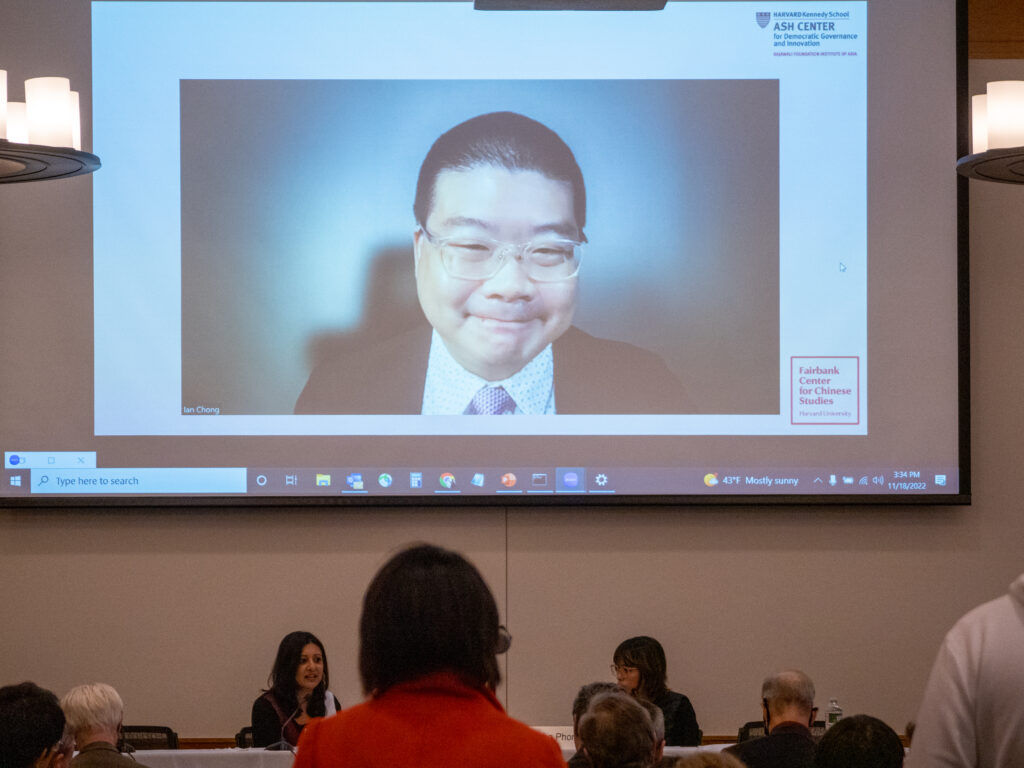A recent panel at our symposium on “Coexistence 2.0” invited participants to discuss how Asian countries navigated tensions between the U.S. and China.
Opening a panel exploring how other Asian countries are grappling with the rise of China and U.S.-China tensions, Fatema Z. Sumar, Executive Director of the Center for International Development, noted that Asian countries are “caught in many ways between the U.S. and China infrastructure politics.” She noted that as Asian countries are dealing with the pandemic, inflation, the transition to net zero emissions, and financing and infrastructure investment gaps, “they are facing many choices.” She asked how Asian countries can balance concerns about Chinese loans becoming “debt traps” with the more positive aspects of Chinese investment, and what the U.S. can offer to Asia versus the negative impacts of trade sanctions on China.
In response, Ian Chong, a professor at National University of Singapore, referred to recent moves to reverse the forces of globalization and decouple the U.S. and Chinese economies. “Singapore…is really a beneficiary of globalization. It’s part of the value chain that links the U.S. with China via various countries including Southeast Asia,” Chong said. “As the U.S. and China grow further apart, because the U.S. is not as internationalist as it used to be… and also, as China is looking more towards internal circulation, that old model of trying to be part of the whole value chain, needs to be rethought. There hasn’t been enough consideration of what the alternatives might be. The default position has been, ‘we don’t want to choose sides.’ But in terms of having more positive options [that would help us] buffer ourselves, we haven’t really come up with a solution.”
Chong said he doesn’t think the U.S. and China are intentionally trying to make Singapore and other countries choose sides. “But let’s look at what they’re doing. They’re not really thinking about Southeast Asia. So they’re creating a situation where there’s more distance, where trying to work with both sides simultaneously and gain the same benefits as before is increasingly difficult.”
Asian countries, including Singapore, he said, “are a bit stuck. There’s a lot of fear of punishment from the PRC, and there’s a lot less confidence in U.S. commitment and engagement with the region than before.”

U.S. Representative Ed Case, who heads the Pacific Islands Caucus, suggested that countries in Asia have concerns about China’s intentions. “Everybody wishes everybody would get along, that we weren’t in this larger geopolitical challenge for whether the international rules-based order will continue or whether there will be an attempt to supplant it or to create an alternative international rules-based order, which would force its own set of choices,” Case said. “And so it is a very uncertain time.”
Case noted that in response to Palau’s close relationship to the United States, China “collapsed its tourism [industry].” He also pointed to Australia as a country that China has punished by cutting off trade. “I personally think that balance is going to get increasingly difficult.”
The Pacific Islands, he said, is a challenge. “For a variety of reasons, [the U.S.] lapsed in terms of continued engagement over the last two decades. China saw a vacuum there and is trying to move in.”

Ed Case joining the panel via Zoom
Ian Chong joining the panel via Zoom

Bopha Phorn, a Cambodian journalist who is currently a Nieman Fellow, described Cambodia’s warming relations with China as a double-edged sword. On one hand, China’s investment in infrastructure—roads, infrastructure, bridges, power—“has been very important for Cambodia to operate the garment industry, the most important sector of the Cambodian economy.” On the other hand, Phorn pointed out the increase in corruption that has coincided with Chinese investment. “Chinese companies are mostly doing business connected with tycoons, the well-connected, powerful people in Cambodia, so most of the money goes to those guys, not directly to the poor people,” Phorn said. “And because of the loosely regulated rule of law, many companies bring in criminal activities. One coastal community became a slave compound run by Chinese criminals and officials who helped them operate.”
Phorn noted that U.S. investment has helped the economy, too—but that the U.S. isn’t doing enough to encourage human rights in Cambodia. “The U.S. may say you need to pay attention to human rights and prevent forest exploitation, but in reality the U.S. invests in countries where it sees more U.S. benefit.” She argued that the U.S. cut off aid for forest protection in response to Cambodia taking funding from China for renovating a huge naval base.

Asked whether China plays the “ethnic card” with the large Chinese population in Singapore, Chong replied that the country is vulnerable because it doesn’t have a clear national identity.
“That creates a certain vacuum for many people, including ethnic Chinese in Singapore, some of whom are looking for this sense of belonging, identity, authenticity.. When China comes along with this claim about Chineseness and that the Chines state is representative of that, it’s attractive to some of these people. That pulls at Singaporean society. It creates a lot of pressure and tension.” Chong pointed to Chinese government interference in Indonesia in the 1960s, which precipitated riots and the massacre of hundreds of thousands of ethnic Chinese Indonesians who were viewed as Communist sympathizers. “The PRC and the Communist Party are political entities. They claim to be synonymous with Chinese culture, with Chinese ethnicity. They are not,” Chong said. “This kind of thing can be very divisive. I don’t think ethno-nationalism worked very well for Germany or for Serbia. I don’t think it’s going to work very well for China, either.”
In final remarks, Phorn underscored the challenges for Cambodian citizens who are caught in the middle between China and the United States. “I have benefited from the economy and the infrastructure, but as a journalist I need a free place to talk, to express myself freely,” Phorn said. “As our leader becomes closer to China, our government is becoming more authoritarian, and that means people like me are having a hard time. That’s why I am here [at Harvard.] The only side that could provide me with this opportunity to use my skills to the fullest, to try to become one of the best reporters, is the U.S. Without doubt, I love the U.S. for that. But what I want more from the U.S. is, come and work with the [Cambodian] government and try to find a way to invest.”
“I don’t want the Chinese government to just take control, to influence Cambodia so much that the U.S. government cannot penetrate and get its stance in Cambodia. It would affect people like me and a lot of Cambodian people,” Phorn said. “The U.S. should ask itself, does it do enough to influence Cambodia? Does it give Cambodian people enough opportunity or windows to study and to learn, to really understand what freedom really means, and how important it is?”


